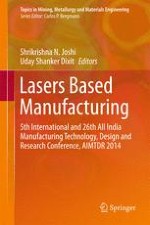2015 | OriginalPaper | Buchkapitel
Fiber Laser Welding in a Controlled Inert Gas Atmosphere: An Experimental and Numerical Investigation
verfasst von : Yadaiah Nirsanametla, Swarup Bag, C. P. Paul, L. M. Kukreja
Erschienen in: Lasers Based Manufacturing
Verlag: Springer India
Aktivieren Sie unsere intelligente Suche, um passende Fachinhalte oder Patente zu finden.
Wählen Sie Textabschnitte aus um mit Künstlicher Intelligenz passenden Patente zu finden. powered by
Markieren Sie Textabschnitte, um KI-gestützt weitere passende Inhalte zu finden. powered by
